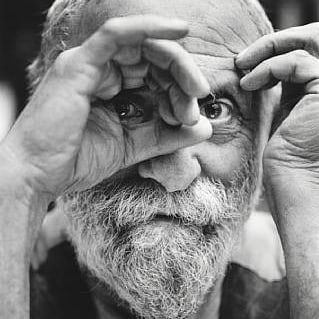César
“I became myself the day I dared to do certain things that I thought were forbidden. To create, you have to have a great freshness, a great naivety. What we call the sacred fire. In the workshop, you forget yourself, and the material transforms you.”
French sculptor César was a protagonist of the Nouveau Réalisme movement in the 1960s, known for his muscular sculptures that explore industrial materials and critique consumer culture. Born César Baldaccini to Italian immigrants in Marseille, France, the artist grew up in the city’s Belle de Mai quarter, an area that was economically depressed. The poverty and detritus he observed there would serve as a significant reference in his artistic practice. César studied classical sculpture and drafting techniques at the École des Beaux-Arts in Marseilles and Paris before moving into a studio beneath the atelier of Alberto Giacometti in the late 1940s. He began collecting scrap metal and forging it into zoomorphic and anthropomorphic forms, and, in 1954, Galerie Lucien Durand, Paris, mounted his first solo exhibition. In 1958, César first exhibited his radical “compressions,” which comprise refuse automobiles and metal that he compacted using a hydraulic press, welding torch, or sledgehammer.
In the early 1960s, César became associated with the Nouveau Réalisme artists alongside founders Yves Klein and Pierre Restany. Members of the group bridged art and life, often applying strategies of collage and assemblage to recycled urban and industrial materials. César had his first New York exhibition at the Saidenberg Gallery in 1961. In 1965, he created a cast of his thumb (Le Pouce), a conceptual self-portrait that he produced in various scales and materials until his death. He initiated his “expansions” in the late ’60s, pouring liquid polyurethane foam into sculptural spills that would expand and set—and he organized a series of happenings in which he performed the making of these works. In 1975, the French film industry commissioned him to design its annual award, the César. He became an officer of the French Legion of Honor in 1993, and, in 1996, he received the Japan Art Association’s Praemium Imperiale prize for sculpture. César participated in the Venice Biennale (1956, 1964, 1995) and Documenta (1959, 1964, 1968).
Numerous retrospectives of César’s work have been organized at museums worldwide, including the Stedelijk Museum, Amsterdam (1966); Musée d’Art Moderne de la Ville de Paris (1976); National Museum of Contemporary Art, Seoul (1996); Palazzo Reale, Milan (1998); Musée Tamayo, Mexico City (1999); and Centre Pompidou, Paris (2017). His work is featured in such prominent museum collections as the Museum of Modern Art and Metropolitan Museum of Art, New York; National Gallery of Art, Washington, DC; Tate, London; and Moderna Museet, Stockholm.
Selected Artworks
- César
- Shock Red 165, 1998
- Sheet Metal, Fiat Marea
- 64 ¹⁵⁄₁₆ × 31½ × 31½ × inches (164.9 × 80 × 80 cm)
- César
- Suite Milanaise, Silver, 1998
- Compressed sheet metal and varnish
- 68¼ × 35 × 31½ inches (173.4 × 88.9 × 80 cm)
- César
- Black Storm 805, 1998
- Compressed sheet metal and varnish
- 61 × 34 × 34 inches (154.9 × 86.4 × 86.4 cm)
- César
- Pavillon, 1986
- Paint, sheet metal, and car part
- 62 × 52½ inches (133 × 185 cm)
- César
- Expansion N 37/10, 1972
- Polyester reinforced with fiberglass, and white lacquer
- 45 × 67 × 69 inches (114.3 × 170.2 × 175.3 cm)
- César
- Expansion Jumelles No 8 "Les jumelles", 1969
- Reinforced polyester and lacquered fiberglass
- 19¾ × 126 × 94½ inches (50.2 × 320 × 240 cm)
- César
- Pouce, 1965/88
- Polished bronze
- 236¼ × 98½ × 137¾ inches (600 × 250 × 350 cm)
- Edition of 8, with 4 APs
- César
- Victoire de Villetaneuse, 1965
- Bronze
- 90½ × 36¼ × 40⅛ inches (230 × 92 × 102 cm)
